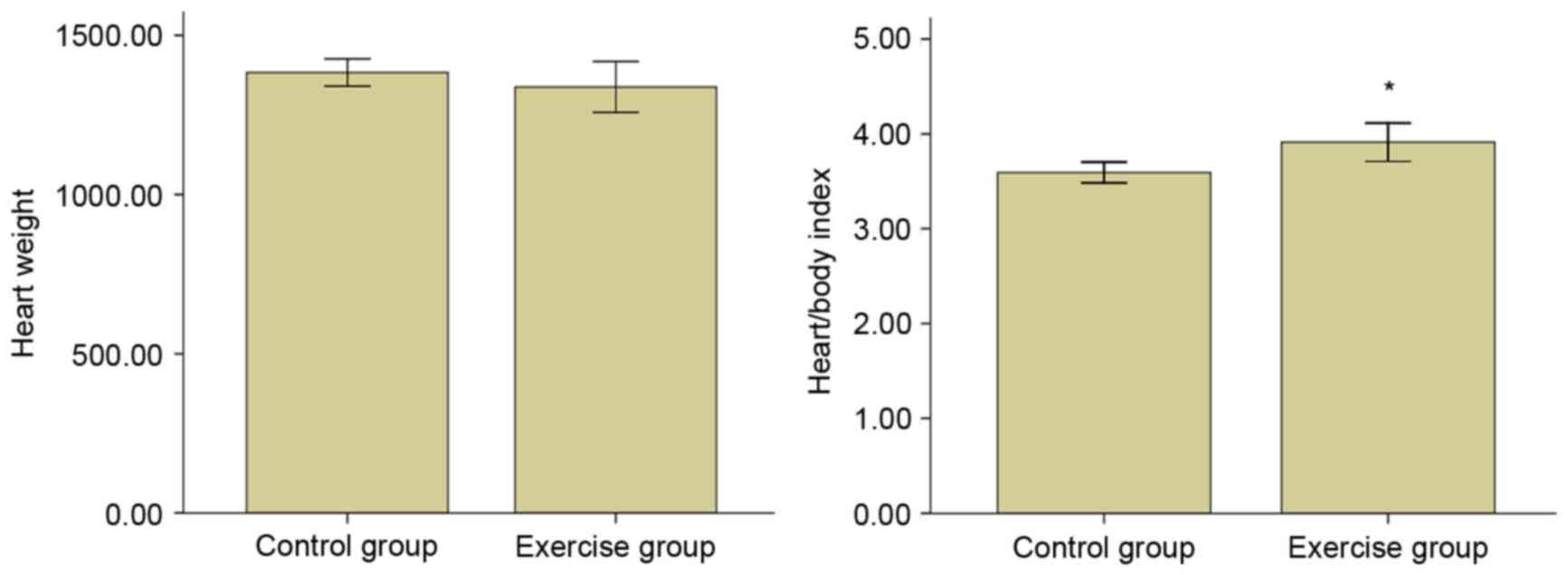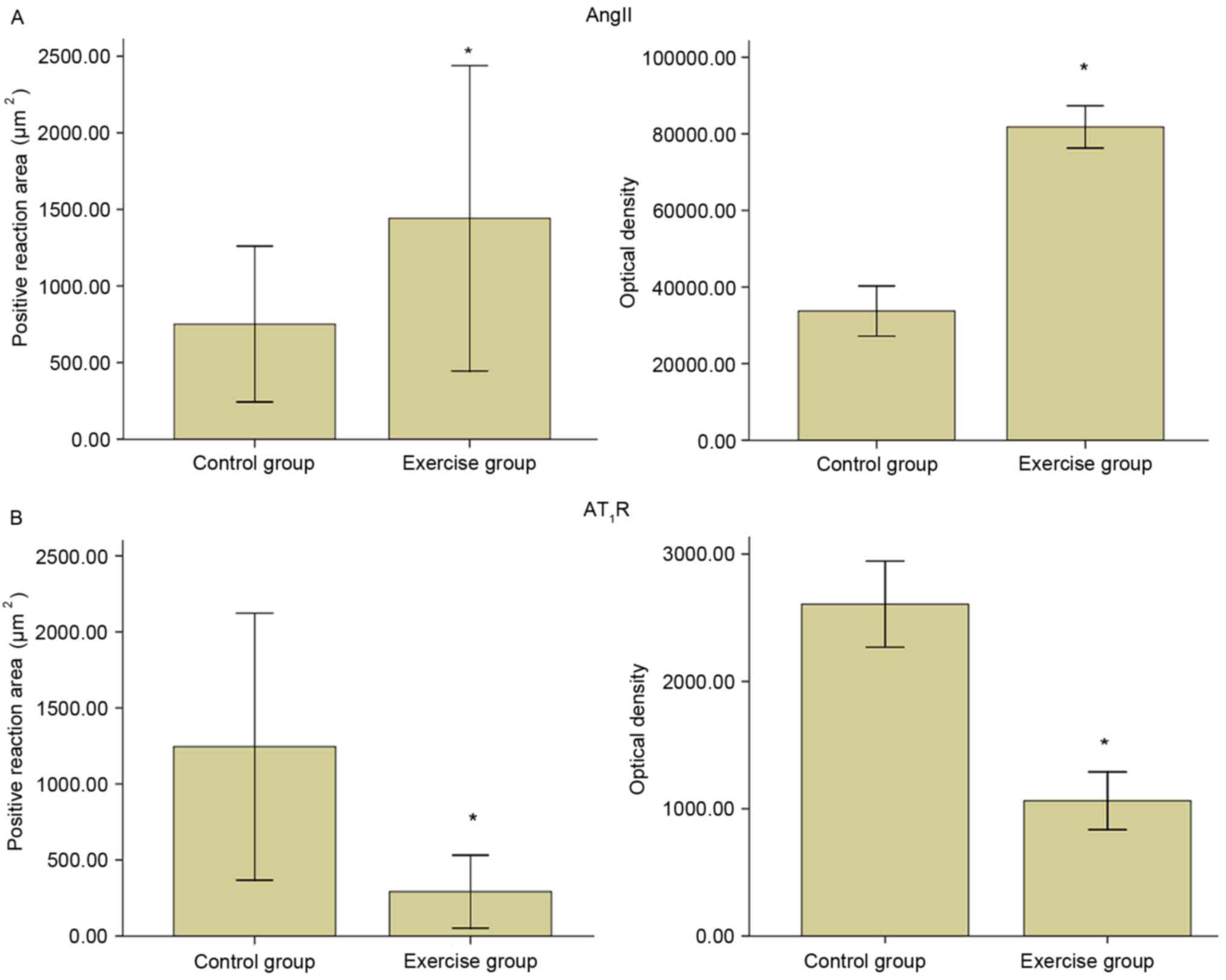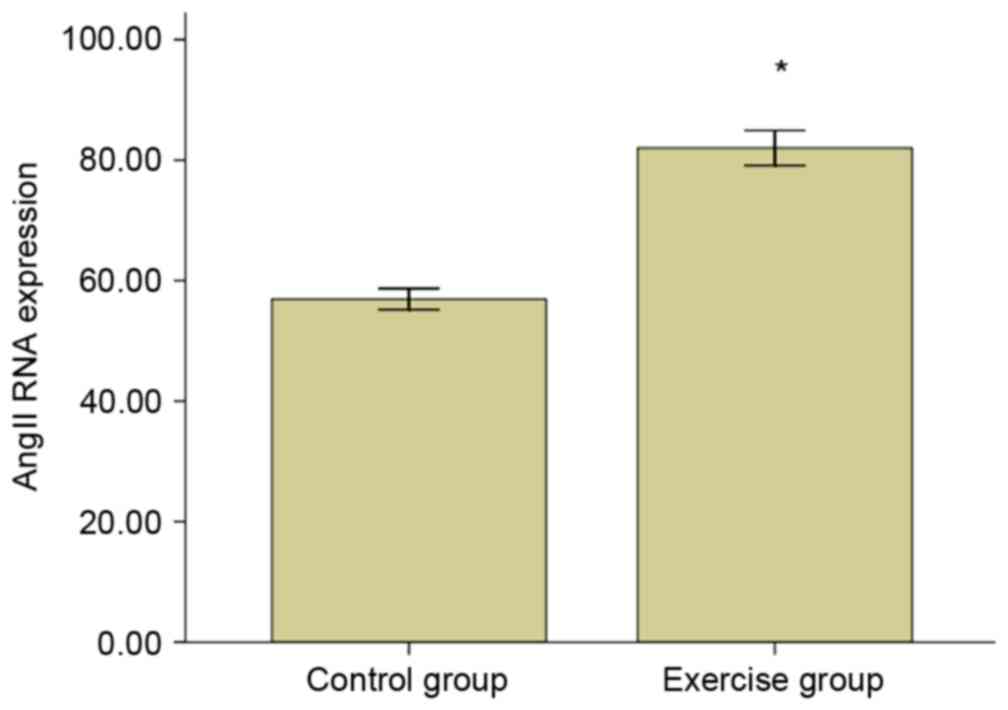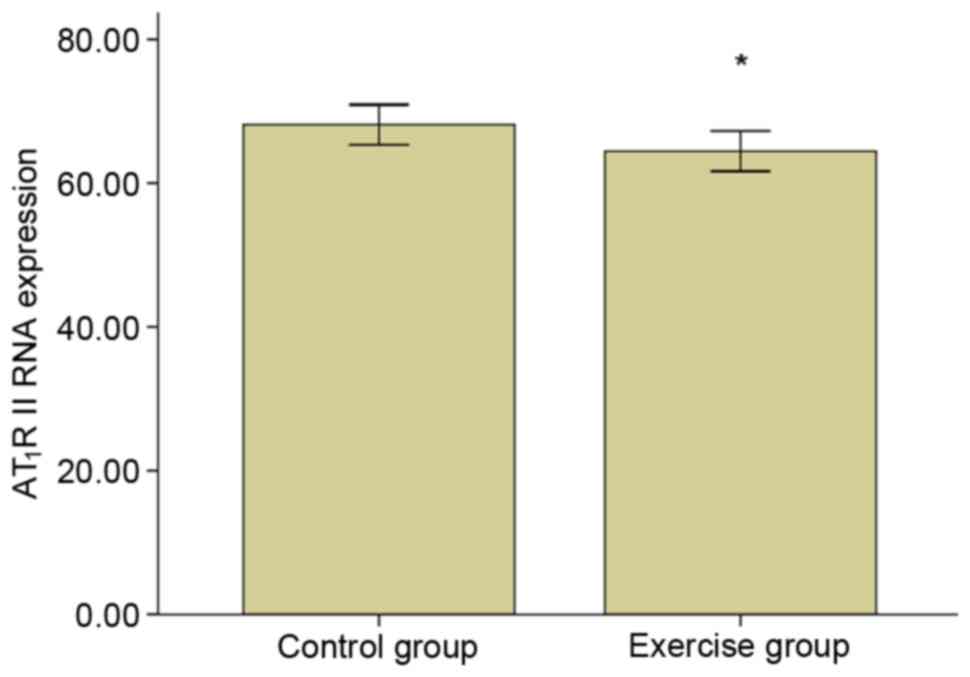Effects of moderate‑intensity endurance exercise on angiotensin II and angiotensin II type I receptors in the rat heart
- Authors:
- Published online on: June 27, 2017 https://doi.org/10.3892/mmr.2017.6864
- Pages: 2439-2444
-
Copyright: © Li et al. This is an open access article distributed under the terms of Creative Commons Attribution License.
Abstract
Introduction
It is well accepted that exercise is beneficial for impaired cardiac function and can improve survival, decrease complications, and abrogate increases in muscle sympathetic nerve activity (1,2). Moderate-intensity endurance exercise is also capable of leading to cardiac hypertrophy in humans, which may worsen cardiac function. Furthermore, patients with impaired cardiac function may have decreased capacity for exercise and increased risk for exercise-related mortality (3).
The local rennin angiotensin system has been identified in the brain and cardiovascular system. Angiotensin II (AngII) serves an important role in the pathology and physiology of cardiac hypertrophy, myocardial injury, hypertension and atherosclerosis. By binding to the AngII type 1 receptor (AT1R), AngII activates a G-protein-coupled receptor, leading to activation of the gene activity and mRNA synthesis, stimulating the protein synthesis and cell growth, and then transforming physical cardiac hypertrophy to pathological cardiac hypertrophy (4). In the pathological alterations of cardiac hypertrophy, the number and affinity characteristics of AT1R are markedly changed. However, to the best of our knowledge, no studies have examined the changes of the cardiac pathological hypertrophy signaling pathway (AngII/AT1R/Gq signaling pathway) on the condition of exercise-induced cardiac hypertrophy. Therefore, the effects of moderate-intensity exercise on the expression and distribution of cardiac local AngII and AT1R were examined in the present study.
Materials and methods
Animals
A total of 40 male Sprague-Dawley rats (age, 3 months; weight, 180–210 g) were purchased from Sichuan Provincial People's Hospital (no. SCXK2008; specific-pathogen-free). The rats were divided into the endurance exercise group (E group; n=20) and control group (C group; n=20). Each group included two sub-groups: Morphological detection group (C1/E1group; n=10) and reverse transcription-quantitative polymerase chain reaction (RT-qPCR) detection group (C2/E2 group; n=10). The rats were housed under specific pathogen-free conditions in an animal facility and given a pelleted regular rodent diet (standard laboratory animal medicine) and water ad libitum. The room temperature was 22–25°C, humidity was 45±10%, and a 12-h light-dark diurnal cycle was used. The current study was approved by the Animal Care and Use Committee of the Sichuan Provincial People's Hospital (Sichuan, China).
Exercise protocol
The endurance exercise group was trained on an animal treadmill. The animals underwent adaptive training for 1 week, the speed of animal treadmill was 10 m/min. The endurance exercise training protocol used was adapted from that of the training protocol from Fenning et al (5), combined with the control method of maximal oxygen uptake of Wisløff et al (6). The exercise intensity remained at 60–65%VO2max. The exercise training lasted for 8 weeks, 6 days a week. The exercise duration was gradually increased from 15 to 50 min. The speed was gradually increased from 10 to 35 m/mins.
Immunohistochemistry
All rats were sacrificed at 24 h following the last session of exercise. The rats were anesthetized by abdominal administration of pentobarbital sodium (4 mg/100 g weight). Subsequent to opening the chest and removing out the whole heart, heart samples of groups C1 and E1 were embedded in paraffin and cut with a standard microtome. Histological sections were cut in 5-µm thick slices and analyzed by immunohistochemical staining for AngII and AT1R expression (Epitomics; Abcam, Cambridge, UK). Briefly, sections were de-waxed and rehydrated. Peroxidase ABC-reagent and 3,3′-diaminobenzidine chromogenic substrate were applied. Treatment with 0.3% H2O2 was used to block endogenous peroxidase activity, for 15–20 min at 25°C, followed by washing with PBS (0.01 mol/l) three times for 5 min. Complex digestive solution was applied for 15 min to increase the permeability of the tissues and cells, followed by washing with distilled water three times for 5 min. Rabbit serum (cat. no. AR1010; Wuhan Boster Biological Technology, Ltd., Wuhan, China) was applied and tissues were incubated for 20 min at 37°C to reduce nonspecific background staining. Afterwards, the slides were washed in Tris-buffered saline and incubated with diaminobenzidine as substrate and counterstained with hematoxylin-eosin. Negative controls without primary antibody were included in each experiment to verify antibody specificity. Primary antibody (1:200, mouse anti-human; cat. no. sc-8431; Santa Cruz Biotechnology, Inc., Dallas, TX, USA) was incubated overnight at 4°C, followed by three washes (5 mins) with PBS (0.01 mol). Biotin-labeled secondary antibody (goat anti-mouse; 1:200; cat. no. SC-1022; Santa Cruz Biotechnology, Inc.) was incubated for 1 h at 37°C, followed by four washes with PBS (0.01 mol).
The sections were observed and images were acquired under alight microscope camera. Using the image analysis software (Image-ProPlus; version 6; Media Cybernetics, Inc., Rockville, MD, USA), the image analysis parameters were automatically generated. A total of 20 slices were selected for each group, and 5 fields of vision were selected to analyze the images. The system measurements used were as follows: i) The average optical density of the positive reaction region in each field of vision; ii) the total area of the test positive region.
RT-qPCR analysis
Total RNA was extracted from heart tissue according to the protocol of the TRIzol reagent (cat. no. BA0290; Wuhan Boster Biological Technology, Ltd.). DNA was extracted according to the protocol of AxyPrep™ Multisource Genomic DNA Miniprepkit (Axygen; Corning Incorporated, Corning, NY, USA). The quality and concentration of the nucleic acids were measured using Gene Quant pro (Biochrom Ltd., Cambridge, UK; version 80-2115-04). cDNA was synthesized as described previously (7).
AngII and AT1R were amplified by the PCR reaction in a 25 µl reaction volume containing 10XPCR buffer, 2.5 mM dNTPs, 50 mM MgCl2, 10 µM forward and 10 µM reverse primers, 0.2 U Platinum® Taq and 10 mg DNA. The PCR cycling conditions were as follows: 94°C for 5 min; 45 cycles of 94°C for 30 sec, 57°C for 30 sec, 72°C for 1.5 min; followed by 70°C for 10 min. RT-qPCR was performed using the Applied Biosystems StepOne™ Real-Time PCR detection system. PCR was conducted in a 25 µl reaction volume containing 10 µl SYBR Green Supermix (Bio-Rad Laboratories, Inc., Hercules, CA, USA), 1 µl each of the specific primer mix (100 nM as final concentration of each primer), 2 µl cDNA and 6 µl nuclease-free water (8). The primer sequences and details of the target genes are presented in Table I.
To obtain the RT-qPCR detection limits for AngII and AT1R, a standard curve based on the quantification cycle (Cq) for a dilution series of pure AngII and AT1R (1, 0.5, 1×10−1, 1×10−2, 1×10−3, and 1×10−4 ng/µl, diluted with 0.1X Tris-ethylenediaminetetraacetic acid buffer) was constructed and triplicate qPCR was performed. In order to quantitatively detect AngII and AT1R in the standard panel samples, another standard curve based on the Cq (8) for the same dilution series.
Statistical analysis
Data were expressed as mean ± standard deviation. The group differences were analyzed using the independent-sample t-test. All data analyses were performed using the SPSS statistical package (version 17.0; SPSS, Inc., Chicago, IL, USA). P<0.05 was considered to indicate a statistically significant difference.
Results
The heart weight and heart/body index of each group
As presented in Fig. 1, no significant differences were identified in the heart weight between the two groups. However, the heart/weight index increased significantly (P<0.05). This indicates that the moderate-intensity endurance training resulted in cardiac hypertrophy.
Immunohistochemical observation of cardiac AngII
The AngII of control group was primarily expressed in the myocardial cell cytoplasm and cell membrane, less in the coronary vessel smooth muscle (Figs. 2 and 3). The immune reaction of AngII of exercise group in myocardial cell and coronary vessel smooth muscle enhanced, the staining density increased (Figs. 2 and 3).
Immunohistochemical observation of cardiac AT1R
The AT1R of group C1 was primarily expressed in the coronary vessel wall smooth muscle cells, and to a lesser extent in the myocardial cell membrane (Figs. 2 and 3). The immune reaction of AT1R of group E1 in myocardial cell and coronary vessel smooth muscle decreased, thus the staining density reduced (Figs. 2 and 3).
Effects of moderate-intensity endurance exercise on Angiotensin II mRNA expression
The standard curve of RT-qPCR for the AngII gene and its regression equation is presented in Fig. 4, which indicated that the fragment had high specificity. The AngII mRNA relative expression level is presented in Fig. 5, demonstrating that the expression for AngII mRNA of the exercise group was increased significantly when compared with the control group (P<0.05).
Effect of moderate-intensity endurance exercise on cardiac AT1R mRNA expression
The standard curve of RT-qPCR for the AT1R gene and its regression equation is presented in Fig. 6, indicating that the fragment had high specificity. The AT1R mRNA relative expression level is exhibited in Fig. 7, which demonstrated that the expression for AT1R II mRNA in the exercise group was significantly decreased compared with the control group (P<0.05).
Discussion
Following the 8-week endurance training, the body weight of E group was significantly reduced compared with the C group. The heart weight/body weight coefficient of group E increased significantly compared with the C group. These observations indicated that the moderate intensity endurance exercise could cause endurance exercise-induced cardiac hypertrophy. Histological analysis demonstrated that the myocardial blood and oxygen supply was not impaired without pathological cardiac hypertrophy.
Subsequent to the 8-week endurance exercise, the immunohistochemistry staining of AngII was observed in cardiac myocytes and coronary vascular wall muscle, while the positive brown staining of myocardial cells was predominantly distributed in the cytoplasm and cell membrane, and less frequently in the cell membrane of the smooth muscle of coronary vessel wall. The expression of cardiac local AngII mRNA increased significantly. These results indicate that AngII is predominantly secreted by cardiac myocytes and coronary vascular smooth muscle cells, and moderate endurance exercise can improve the content of AngII in the heart. Cardiac hypertrophy is a compensatory mechanism in case of chronic long-term overload, and the elevated expression of AngII serves an important role in the pathological myocardial hypertrophy (9). The results demonstrated that the 8-week moderate intensity endurance training led to cardiac hypertrophy, histological examination exhibited no pathological changes, indicating that AngII increase, which was stimulated by moderate endurance exercise, is a benign adaptation to movement. When the exercise intensity was increased, the volume load and pressure load will be larger. Myocardial cells were hypertrophied and the cardiac local AngII content and angiotensin-converting-enzyme activity increases, which suggests that there are correlations between the secretion of cardiac local AngII and the training load (10); the positive correlation suggests that under the condition of overload exercise stimulation, the heart will be transformed from a physiological cardiac hypertrophy to decompensate pathological hypertrophy, and the changes of cardiac local AngII may be important factors.
The AngII/AT1R signaling pathway is necessary for cardiac renin-angiotensin system function, and the biological function of local AngII is implemented by AT1R (11). AT1R undergoes rapid internalization and desensitization when stimulated by AngII; on the one hand, it can stimulate endothelial cells to produce endothelin, contract the coronary artery, decrease myocardial capillary density and aggravate myocardial ischemic injury (12). In addition, AT1R can couple with Gq proteins, activate phospholipase C-β, and hydrolysis the phosphatidylinositol biphosphate to diacylglyceroland inositol triphosphate (13). Subsequently, it serves an important role in the myocardial cell apoptosis, necrosis, and cardiac pathological hypertrophy. When the expression and characteristics of AT1R change, simultaneously, the cardiac endogenous active peptides that can induce cardiac hypertrophy (e.g. atrial natriuretic factor or insulin like growth factor 1) will correspondingly change (14). This indicates that the alteration of the activity of the receptor is an important for AngII to induce cardiac hypertrophy, the change of the quantity of AngII does not appear to be an important factor. The experimental results indicated that following eight weeks of moderate intensity endurance exercise, the cardiac local AT1R mRNA expression of the rats was significantly reduced. Immunohistochemical testing indicated that moderate intensity endurance training, the immune positive reaction and optical density of AT1R in all levels of coronary vascular smooth muscle and cardiac cells were markedly reduced. Therefore, it is suggested that after eight weeks of moderate intensity endurance training, heart local AT1R expression is significantly reduced. It is hypothesized that the main reason for AT1R downregulation may be that AngII has a positive moderating effect on the myocardium, it can induce cardiac hypertrophy, and the AT1R distribution gradually reduces. This is the protective mechanism to avoid producing pathological cardiac hypertrophy changes. The receptor distribution reduction in coronary vascular smooth muscle can prevent coronary excessive vasoconstriction; prevent cardiac ischemia and hypoxia, so as to ensure the energy metabolism required for the heart to function. In addition, moderate intensity endurance exercise induces increased AngII feedback, which can stimulate AT1R to AT2R transformation, which has a contrasting effect on cell growth, proliferation, vascular tension and vasopressin release (15); or is decomposed by angiotensin converting enzyme 2 to Ang(1–7), which leads to indirect cardioprotective effects. It is suggested that after the 8-weeks exercise, upregulation of cardiac local AngII and downregulation of AT1R is protective towards the heart, which can prevent transforming pathological cardiac hypertrophy and coronary vascular excessive vasoconstriction, and is also important in maintaining the cardiac load demand and energy metabolism under the physiological state (16). In the current study, the cardiac AngII expression was increased after the 8-week moderate intensity endurance training, which indicated that cardiac AngII is involved in the heart physiological function via autocrine, paracrine and intracrine mechanisms. It is suggested that AngII may participate in the physiological functions of other organs via blood circulation. Cardiac hypertrophy was induced when the rat cardiac AT1R expression was downregulated, which suggests that AngII through the AT1R signaling pathway may not serve a major role in endurance training-induced cardiac hypertrophy. Meanwhile, there is a significant difference between the downregulation of AT1R expression and the upregulation of AT1R expression under pathological cardiac hypertrophy, which indicates that receptor number and/or affinity changes are the key factors for physiological cardiac hypertrophy becoming pathological cardiac hypertrophy, the expression change of AngII itself does not lead to the characteristics of cardiac hypertrophy.
AngII was predominantly distributed in the cell cytoplasm and cell membrane, and rarely in coronary vascular wall smooth muscle cells. AT1R was predominantly distributed in the coronary vessel wall smooth muscle cells, however was rarely present in cardiac cells. Following the 8-week endurance training period, the AngII expression was increased and the AT1R expression was decreased. AT1R may expand the coronary artery, thereby increasing coronary blood flow and ensuring the energy supply of the heart during exercise. The expression changes in AngII do not reflect the character of cardiac hypertrophy. The exercise-induced change in the expression of AngII and AT1R may be a protective mechanism to avoid cardiac pathological hypertrophy.
Acknowledgements
The current study was supported by grants from the Fundamental Research Funds for the Central Universities, China (grant no. 12JCY07), Chengdu University Funding (grant no. 2012ZJZ01) and the 2013 Annual Research Projects from Education Department of Sichuan Province (grant no. 13ZB0340).
References
|
Haack KK, Engler CW, Papoutsi E, Pipinos II, Patel KP and Zucker IH: Parallel changes in neuronal AT1R and GRK5 expression following exercise training in heart failure. Hypertension. 60:354–361. 2012. View Article : Google Scholar : PubMed/NCBI | |
|
Rajani R, Rimington H and Chambers JB: Treadmill exercise in apparently asymptomatic patients with moderate or severe aortic stenosis: Relationship between cardiac index and revealed symptoms. Heart. 96:689–695. 2010. View Article : Google Scholar : PubMed/NCBI | |
|
Lou H, Danelisen I and Singal PK: Involvement of mitogen-activated protein kinases in adriamycin-induced cardiomyopathy. Am J Physiol Heart Circ Physiol. 288:H1925–H1930. 2005. View Article : Google Scholar : PubMed/NCBI | |
|
Haudek SB, Cheng J, Du J, Wang Y, Hermosillo-Rodriguez J, Trial J, Taffet GE and Entman ML: Monocytic fibroblast precursors mediate fibrosis in angiotensin-II-induced cardiac hypertrophy. J Mol Cell Cardiol. 49:499–507. 2010. View Article : Google Scholar : PubMed/NCBI | |
|
Fenning A, Harrison G, Dwyer D, Rose'Meyer R and Brown L: Cardiac adaptation to endurance exercise in rats. Mol Cell Biochem. 251:51–59. 2003. View Article : Google Scholar : PubMed/NCBI | |
|
Wisløff U, Helgerud J, Kemi OJ and Ellingsen O: Intensity-controlled treadmill running in rats: VO(2 max) and cardiac hypertrophy. Am J Physiol Heart Circ Physiol. 280:H1301–H1310. 2001.PubMed/NCBI | |
|
Xin LI: Effect of moderate-intensity endurance exercise on the expression of cardiac signaling pathway. East China Normal Univ. 2011. | |
|
Livak KJ and Schmittgen TD: Analysis of relative gene expression data using real-time quantitative PCR and the 2(−Delta Delta C(T) method. Methods. 25:402–408. 2001. View Article : Google Scholar : PubMed/NCBI | |
|
Kohli S, Ahuja S and Rani V: Transcription factors in heart: Promising therapeutic targets in cardiac hypertrophy. Curr Cardiol Rev. 7:262–271. 2011. View Article : Google Scholar : PubMed/NCBI | |
|
Belardinelli R: Exercise training in chronic heart failure: How to harmonize oxidative stress, sympathetic outflow, and angiotensin II. Circulation. 115:3042–3044. 2007. View Article : Google Scholar : PubMed/NCBI | |
|
Zhang GX, Ohmori K, Nagai Y, Fujisawa Y, Nishiyama A, Abe Y and Kimura S: Role of AT1 receptor in isoproterenol-induced cardiac hypertrophy and oxidative stress in mice. J Mol Cell Cardiol. 42:804–811. 2007. View Article : Google Scholar : PubMed/NCBI | |
|
Jugdutt BI and Sawicki G: AT1 receptor blockade alters metabolic, functional and structural proteins after reperfused myocardial infarction: Detection using proteomics. Mol Cell Biochem. 263:179–188. 2004. View Article : Google Scholar | |
|
Bai H, Wu LL, Xing DQ, Liu J and Zhao YL: Angiotensin II induced upregulation of G alpha q/11, phospholipase C beta 3 and extracellular signal-regulated kinase 1/2 via angiotensin II type 1 receptor. Chin Med J (Engl). 117:88–93. 2004.PubMed/NCBI | |
|
Anavekar NS and Solomon SD: Angiotensin II receptor blockade and ventricular remodelling. J Renin Angiotensin Aldosterone Syst. 6:43–48. 2005. View Article : Google Scholar : PubMed/NCBI | |
|
Jiang XY, Gao GD, Du XJ, Zhou J, Wang XF and Lin YX: The signalling of AT2 and the influence on the collagen metabolism of AT2 receptor in adult rat cardiac fibroblasts. Acta Cardiol. 62:429–438. 2007. View Article : Google Scholar : PubMed/NCBI | |
|
Fatini C, Guazzelli R, Manetti P, Battaglini B, Gensini F, Vono R, Toncelli L, Zilli P, Capalbo A, Abbate R, et al: RAS genes influence exercise-induced left ventricular hypertrophy: An elite athletes study. Med Sci Sports Exerc. 32:1868–1872. 2000. View Article : Google Scholar : PubMed/NCBI |
















